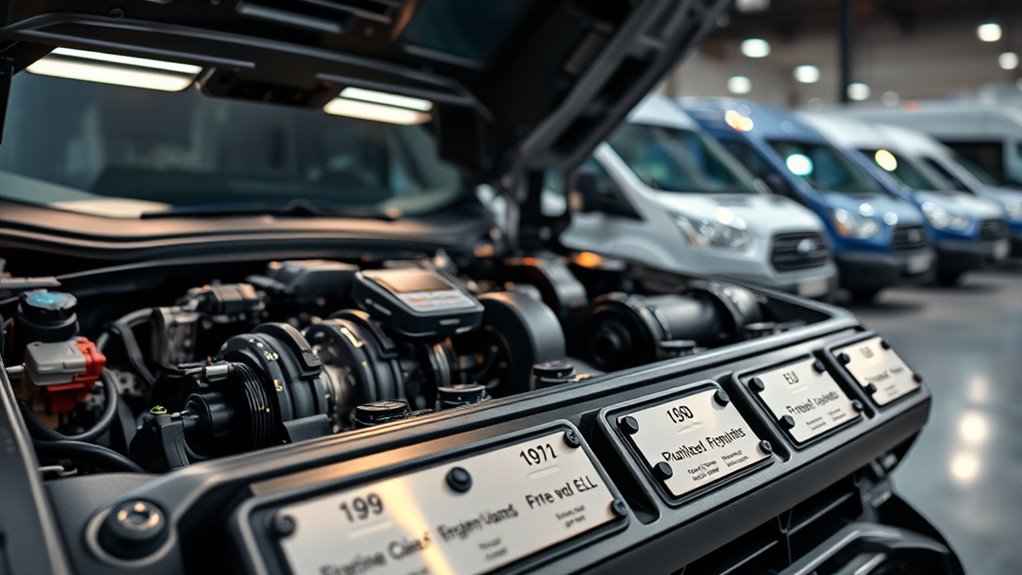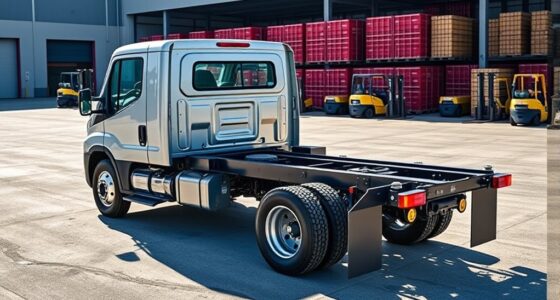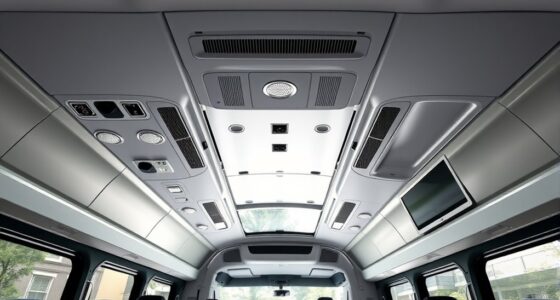Ford Transit engine options vary by year and region. In the US, models since 2015 featured V6 engines, including the EcoBoost turbocharged options for better efficiency and power, with newer models focusing on smaller, turbocharged four-cylinder engines. In Europe, diesel engines like the 2.0-liter EcoBlue and bi-turbo setups dominate for their economy and emissions compliance. By continuing, you’ll discover detailed engine choices across specific years and markets.
Key Takeaways
- US Ford Transit engines shifted from 3.7L V6 and 3.2L diesel (2015-2019) to 3.5L EcoBoost V6 and turbocharged four-cylinder options post-2020.
- EU Ford Transit primarily uses smaller turbocharged diesel engines like the 2.0L EcoBlue, with bi-turbo variants for efficiency and torque.
- US models emphasize gasoline V6 and EcoBoost engines balancing power and fuel economy, with diesel options for heavy-duty needs.
- European models focus on diesel engines to meet emission standards, favoring efficiency and urban delivery applications.
- Both markets have moved toward turbocharged, direct-injection engines to improve performance, reduce emissions, and meet evolving standards.

The Ford Transit offers a range of engine options designed to suit various commercial needs, whether you’re hauling cargo, transporting passengers, or running a small business. Over the years, Ford has continuously updated and refined these engines to improve performance, efficiency, and reliability across different markets.
The Ford Transit’s versatile engine lineup adapts to diverse commercial needs worldwide.
If you’re considering a Transit, understanding the available engine choices by year can help you select the best fit for your operations.
In the US, the latest models typically feature a standard 3.5-liter V6 engine that balances power and fuel economy, making it suitable for most commercial applications. For those needing more punch, Ford has introduced a 3.5-liter EcoBoost V6, offering turbocharged performance with better fuel efficiency. Diesel options are also available, like the 2.0-liter EcoBlue four-cylinder engine in recent years, which provides excellent torque and fuel economy, especially beneficial for long-distance hauling or heavy loads.
Ford has also offered a 3.2-liter Power Stroke diesel engine in earlier models, known for durability and high torque output, making it a favorite among fleet operators.
Across different model years, the engine lineup has shifted to emphasize efficiency and emissions compliance. For example, the 2015-2019 US Transit models primarily relied on a 3.7-liter V6 and a 3.2-liter diesel, with the 3.5-liter EcoBoost introduced later to enhance power delivery and fuel savings.
By 2020, Ford moved towards turbocharged four-cylinder engines across many trims, focusing on reducing weight and improving fuel economy without sacrificing performance. The newer engines tend to be smaller but more technologically advanced, featuring direct injection and turbocharging to maximize output and efficiency.
In Europe, the engine options reflect stricter emission standards and a different market demand. The Transit models there have long relied on smaller, turbocharged engines like the 2.0-liter EcoBlue diesel, which balances power and economy efficiently.
Over the years, Ford has expanded the availability of these engines, offering different tuning levels to cater to urban delivery, passenger transport, or heavy-duty tasks. The EU versions tend to have more diesel options due to fuel economy preferences and diesel’s widespread use in Europe.
Additionally, some models include bi-turbo configurations, providing better torque at lower RPMs, which is especially useful for city driving and stop-and-go conditions. Furthermore, the shift toward turbocharged engines reflects Ford’s focus on meeting stricter emissions standards and improving fuel efficiency across markets.
Frequently Asked Questions
How Do Engine Options Vary Between US and EU Ford Transit Models?
You’ll notice that US Ford Transit models mainly offer gasoline engines, like the 3.5L V6 and 2.0L EcoBlue diesel.
EU versions provide a broader range, including 2.0L EcoBlue diesel options and more efficient turbocharged engines.
EU models often focus on fuel efficiency and emissions, with some variants featuring mild-hybrid systems.
Consequently, engine choices differ markedly, reflecting regional regulations and market preferences.
Are There Any Hybrid or Electric Engine Options Available for the Ford Transit?
Yes, you can find hybrid and electric options for the Ford Transit. Ford offers the Transit Custom PHEV (Plug-in Hybrid Electric Vehicle) in Europe, combining an electric motor with a gasoline engine for reduced emissions and fuel costs.
In the US, Ford has introduced the all-electric E-Transit, designed for commercial use with zero emissions. These options are ideal if you’re looking for eco-friendly, efficient transportation solutions.
Which Engine Offers the Best Fuel Economy Across Different Years?
You’ll find that the diesel engines generally deliver the best fuel economy in the Ford Transit across various years.
Specifically, the 2.0-liter EcoBlue diesel engine in EU models offers impressive miles per gallon, especially in newer versions.
In contrast, gasoline engines tend to consume more fuel.
If fuel efficiency is your priority, opting for a diesel engine is your best choice, as it consistently outperforms other options in fuel economy.
How Have Engine Emissions Standards Impacted Ford Transit Engine Choices?
Think of emissions standards as a strict coach pushing Ford to choose cleaner engines. These regulations force you to prioritize low-emission options, leading Ford to adopt turbocharged diesel engines and hybrid tech to meet standards.
As a result, you now see more efficient, eco-friendly engines in the Transit lineup. The standards act like a compass, guiding Ford toward sustainable choices that lower environmental impact while maintaining performance.
What Are the Common Maintenance Issues for Different Ford Transit Engines?
You’ll likely face common maintenance issues like turbocharger failures in turbocharged engines, oil leaks, and fuel injector problems across different Ford Transit engines.
Diesel variants may experience glow plug or EGR valve issues, while gasoline models could have spark plug or ignition coil troubles.
Regularly check fluid levels, replace filters, and keep up with scheduled maintenance to prevent costly repairs and guarantee ideal engine performance.
Conclusion
Whether you’re choosing based on power, efficiency, or versatility, the Ford Transit engine options offer something for everyone. From the robust V6 to the fuel-efficient diesel, each engine suits different needs and preferences. Consider your cargo, your budget, and your driving style. Make your choice with confidence, knowing you’ll get reliability, performance, and value. In the end, your perfect Transit engine balances strength with efficiency, performance with economy, and versatility with dependability.









